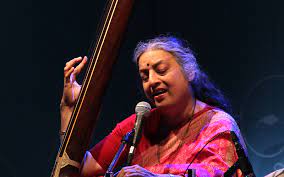Ashwini Bhide-Deshpande mesmerises audiences at the 69th Savai Gandharva Bhimsen Mahotsav with her transcendent rendition of raga Kafi Kanada.
Amidst the distinguished vocalists within the Jaipur-Atrauli tradition of Khyal singing, Ashwini Bhide-Deshpande stands out as an artist of remarkable caliber. Drawing inspiration from her mother’s esteemed style, Ashwini has not only embraced its finest aspects but has also enriched her repertoire with profound sensitivity and intellectual depth. Her performance at the 69th Savai Gandharva Bhimsen Mahotsav‘s second evening at Pune was a testament to her mastery. Through systematic exposition of Raag structure, impeccable phrasing, diverse taan patterns, and a seamless and graceful navigation across all three octaves, Ashwini Bhide-Deshpande captivated the audience with a fascinating rendition of raga Kafi Kanada.
The raga comes alive
Ashwini Deshpande chose the traditional composition “Lai Re Madha Piya” in Vilambit Teental. From the initial “Sa,” raga bhava permeated her naturally melodious voice. An aura of rigorous and painstaking Sadhana, cultivated over many years, resonated in each note. Specializing in a beautiful exposition of the raga in both the lower and middle octaves at a slow tempo, she meticulously elaborated on each crucial note in the raga. Holding the audience’s attention through Alapchari is a challenging task, yet Ashwini, akin to legends like Pandit Jitendra Abhisheki and Vidushi Kishori Amonkar, effectively and consistently achieved this feat. She not only upheld the tradition but also transcended the grammar of the Raga, infusing emotion into her rendition.
Transcending tradition
Echoing the words of yesteryear legends, “when one sings a Jod Raga, he/she should have such mastery on both the ragas, that they should appear as a single raga.” Ashwini executed this brilliantly. Her Kanada phrases interwoven with Kafi phrases, involving the note Shuddha Dha (an essential note in Kafi), created a seamless union of bodies possessing one soul. Notably, the use of Komal Ga during the alapi added depth. The Raga encompasses both the oscillated Ga of Kanada and the plain Ga of Kafi, and Ashwini’s judicious use of this note, denoting the appropriate Raga in context, was a treat for rasikas and a valuable lesson for aspirants.
Following the alapi, the bol-alaps and Tans showcased how intricate patterns could be created without compromising the Raga structure. Suyog Kundalkarji exhibited excellent accompaniment, showcasing mastery over both his instrument and the Raga. After the Vilambit, the Drit Bandish “Kanha Kunvar Ke,” a poem from Haveli Sangit, written by Nand Das and set to tune by Ashwini herself, was rendered. The unique aspect of this tune was the representation of both Kafi and Kanada in alternate lines.
Ashwini was accompanied by Suyog Kundalkar on Harmonium and Bharat Kamat on Tabla. Bharat Kamatji displayed his Tabla prowess during the Antara line, “Megha Mridangi Mridanga Bajavata”. Vocal support was provided by Shamika Bhide and Swarangi Marathe.
The rendition concluded with cascades of Tans performed at a brisk pace. All in all, it was a brilliant and soulful performance.

